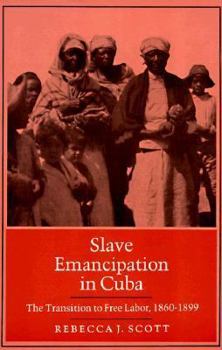Slave Emancipation in Cuba: The Transition to Free Labor, 1860-1899
Select Format
Select Condition 
Book Overview
Slave Emancipation in Cuba is the classic study of the end of slavery in Cuba. Rebecca J. Scott explores the dynamics of Cuban emancipation, arguing that slavery was not simply abolished by the... This description may be from another edition of this product.
Format:Paperback
Language:English
ISBN:0691101574
ISBN13:9780691101576
Release Date:February 1986
Publisher:Princeton University Press
Length:356 Pages
Weight:1.16 lbs.
Dimensions:9.5" x 1.0" x 6.5"
Customer Reviews
1 rating
Careful analysis of a complex process
Published by Thriftbooks.com User , 19 years ago
Professor Scott makes exemplary scholarship look easy. Having just finished William Freehling's "Road to Disunion: Secessionists at Bay 1776-1854", a brilliant exposition of the sociopolitical history of the U.S. antebellum South, I wanted to see how another nineteenth-century New World society, also heavily invested in slavery, ended the institution. I was gratified to find one of the most carefully written modern histories I have ever read. Using clear, direct prose, Scott effortlessly renders nineteenth-century Cuba's variegated social geography, its tortuous legal gymnastics, and the complicated social and racial tensions that determined the course of emancipation. In the process, she disassembles previous explanations of why Cuban slavery devolved as it did: for instance, she demonstrates that slavery was not antithetical to technological advancement or intensified capitalist organization of sugar production. Her detailed treatment of the role and nature of Chinese indentured labor--its relationship to slavery; the economic, ethnic and social dimensions of the opportunities it offered plantation owners and managers--comprises a breathtaking glimpse into the grim polyethnic logic of plantation profits in the New World, even as it demolishes theories that the presence of Chinese laborers reveals the fatal weaknesses of slave labor in Cuba. Indeed, one of the enduring themes of the period is the bewilderingly hybrid nature of Cuban plantation labor during the transition away from slavery. At any given sugar mill, one might encounter slaves (both African and Afro-Cuban), Chinese indentured laborers, autonomous gangs of Chinese contractors, prisoners, free wage-earners, tenant farmers and Spanish soldiers all breaking their backs to harvest and process the cane. One is also left with a clear picture of the dramatic geographic differences--the huge and technically advanced mills of Matanzas in the west, Havana's distinctly urban dynamic, the east's rebellious and racially mixed smallholders. Add to this the turbulent military and colonial contests that shaped, and were shaped by, the process of emancipation, and Professor Scott's achievement becomes even more astonishing. Throughout all this, she smoothly incorporates illuminating quantitative analysis (in the form of dozens of tables), and poignant personal dramas as slaves persistently participated in the processes that would determine their freedom.




